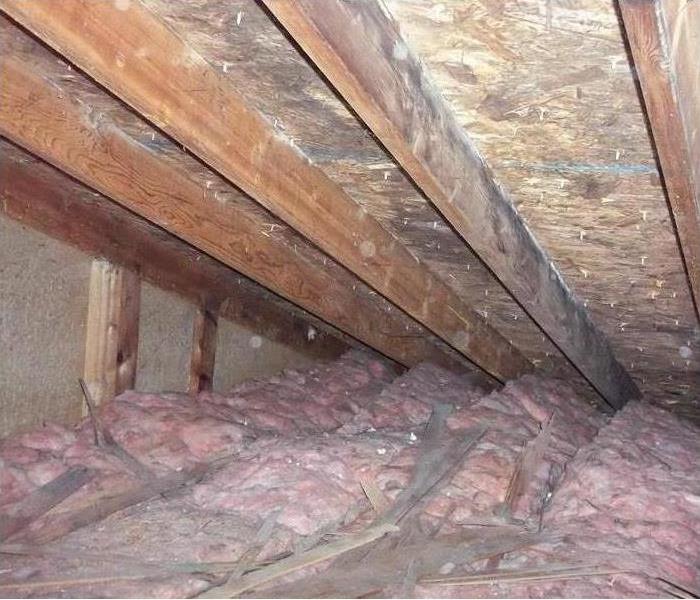Mold In The Attic
4/14/2020 (Permalink)
If you’re like most of us, you rarely if ever venture into your home’s attic. Why would you? It’s not usually a place you care to venture and for the most part if you do it’s because something isn’t going well. With warmer temps here for the summer, we start to see an increase in jobs where homeowners have discovered mold damage in their attic. In this blog post, we’ll talk through what we typically see when homes have considerable amounts of attic mold and help you understand ways you can make sure it doesn’t happen to you.
Why mold grows in attics
Mold damage in your attic space occurs for the same reasons it occurs anywhere else in a dwelling. It’s a combination of a few things:
() the right temperature – mold spores like warmer, ambient temps. In fact, it likes about the same temp range as we do, between 60-80 degrees Fahrenheit.
() food – no, not crumbs from discarded food a home service technicians might have left while doing some work up in your attic long ago. Mold likes anything that is high in cellulose. Unfortunately for homeowners, that’s pretty much anything in your attic, like plywood, wood joists, roof decking, etc.
() elevated moisture – many homeowners don’t realize that moisture is found in every surface of their home, as it should be. If those surfaces were completely devoid of moisture they wouldn’t perform their duties properly. But if a surface gets too much moisture in it, that’s the trigger mold needs to start growing. Another thing most homeowners don’t realize is that mold spores are present in most environments, and certainly in every home or other type of dwelling. It exists naturally and in low levels and is completely harmless to humans and pets. But with the right conditions, it can grow quickly and spread, causing wide spread damage to your home and potentially cause health effects for the home’s inhabitants.
As you can see from the list above, 2 of those things are normal. It’s the 3rd thing, elevated moisture that is not normal and creates the right environment for a mold problem. So now let’s talk through how moisture gets into attics and what you can do to make sure it doesn’t get into yours.
Causes of attic mold growth
When we are called to a home and discover mold in the attic, the culprits are usually pretty easy to spot. There are only so many ways moisture finds its way into an attic. Here’s what we usually see:
Venting directly into the attic
Many bathrooms are equipped with vents that take the warm, wet air released when a shower is running and remove it from the bathroom. Unfortunately, sometimes a misguided homeowner or shoddy handyman will simply install the vent fan such that the air is pushed into the attic where it has nowhere to escape. Bathroom fans should be vented to the outside of the house. If you have an older home that is equipped with one or multiple of these types of exhaust fans, it’s probably worth you taking a look in the attic space to make sure it’s vented properly.
A leaky roof
One culprit we find when inspecting an attic with mold is a leaky roof. Just one damaged or misplaced shingle can allow rain water to slowly seep into your attic. While most people picture a deluge of water coming through their ceiling, more often than not, a roof leak will just allow a slow amount of rain water to enter the attic, usually soaking the roof deck and eventually dripping down onto the attic floor and/or your exterior walls. We recommend that you (safely) inspect your roof’s exterior each spring and it’s also a good idea to just crawl up into your attic and peer at the interior decking of the roof. If you start to see staining, it’s a sign you have some moisture intrusion that needs to be addressed!
Improper Ventilation
Your attic needs to breathe. When we have extended periods of extremely cold weather like we had this past winter, warm air leaks from the interior of your home into the attic. This warm wet air will condensate on the roof deck and possibly ice over the ventilation. One it warms up, this frost will thaw causing the roof deck to get wet. One sign to look for is roofing nails that are rusty. We recommend working with an insulating contractor to make sure your attic vents well so you can avoid this problem.
With a few simple steps and things to be mindful of your attic can remain trouble free. If you suspect you have a problem feel free to give us a call. 651-705-7028






 24/7 Emergency Service
24/7 Emergency Service
